
Life's rich tapestry: traditional arts and crafts thriving around the world
May 6, 2019 • 6 min read

Quilting is often a collaborative effort in the USA. monkeybusinessimages / Getty Images
Part of our cultural identities, arts and crafts are woven into the fabric of society. Although some traditions have unravelled over time, others remain as vital as ever. And with the search for authentic experiences high on the modern travel agenda, these skills – from tribal tattooing to communal quilting – are drawing crowds like never before. Here are some of the world’s most compelling traditional arts and crafts, plus some suggestions on how to learn more about them.
Kalinga tattooing in the Philippines
Amid the rice terraces of the Philippines’ Kalinga province, the tribal community of Buscalan holds a secret: this rural barangay (the country’s smallest administrative region), is home to Whang-od – a matriarch, businesswoman and national celebrity, standing firm at 102 years old. Her trade? Using the same citrus thorns, charcoal ink and bamboo hammer as generations of her ancestors, Whang-od has spent eight decades decorating skin of her people, plus a steady stream of visitors eager to be inked by a living legend.
In Filipino culture, the tattoo, or batok, is more than ornamental. Symbolising everything from fertility to dexterity in battle, each is earned and respected. As the last ever tribal tattooist to hold the title of mambabatok, meaning ‘master’, Whang-od’s skills are revered. Not content with fame, she is passing on her skills to a new generation of young women, who financially support the village by serving tattoo-seeking travellers.
Try it yourself: Whang-od may not be able to teach you her lifelong skills, but those willing to venture to Buscalan can pay to receive a traditional tattoo from one of her apprentices.
Faroese knitting in the Faroe Islands
Slow, rhythmic and passed down through generations, Faroese knitting mirrors the local way of life on these unforgiving islands in the North Atlantic. The thick fabric made from wool produced here is not only a source of protection from the elements, but also a celebration of the undulating landscape and native flora, which inform distinctive Faroese patterns. And with young designers using the patterns documented in Føroysk Bindingarmynstur – the ‘bible’ of Faroese motifs – to create fresh, modern designs, the craft is thriving.
But what really weaves Faroese knitting into the islands’ identity is the way it brings people together. There is no truer representation of Faroese culture than the lively, vibrant atmosphere of a knitting group, as locals young and old gather to swap patterns, spin yarns and foster close-knit communities.
Try it yourself: If you’re itching to have a go, rock up to Ribarhús & Piddasahandil, an arts and crafts society in the Faroese town of Fuglafjørður.

Origami in Japan
Whether it was a basic paper fan or elegant napkin crane, chances are that you have tried your hand at the delicate Japanese art of origami. Although the origins of the craft are unclear, it is widely accepted that the technique was developed some time after Buddhist monks brought paper to Japan in the 6th century.
Having endured for thousands of years in one of the world's most technologically advanced nations, origami has found a new lease of life thanks to Japan’s wellness scene. The combination of repetitive creasing and constructing has seen it gain popularity as a timeless, mindful method of relaxation, a counterbalance to the breakneck pace of modern life.
Try it yourself: This workshop in Kyoto teaches the ancient art of paper folding, but similar sessions can be found in most major Japanese cities.

Zellige tiling in Morocco
Instagram feeds are alive with examples of these intricate tiles, which adorn everything from decadent hammams to Moorish architecture. Islam forbade the depiction of human or animal figures in decorative art, which spurred the development of these distinctive geometric patterns.
Using a technique dating back to the 10th century, zellige tilers are master craftsmen whose training begins in childhood and passes down through families. And now it's boom time for many family-run Moroccan businesses who make these tiles, as high-end hotels, spas and resorts around the world seek out their skills.
Try it yourself: Admire the beauty of zellige tiles and learn about other traditional Moroccan arts and crafts on this tour of Fes Medina.
Kite making and flying in India
The sight of kites duelling above Delhi on Independence Day in August is a symbol of freedom that celebrates India’s liberation from British rule. Kite making, kite flying and kite fighting are popular throughout India but the capital has become this tradition's spiritual home, hosting the annual Kite Flying Festival in January.
Professional kite flyers and kite-flying families bring their time-honoured techniques to bear on modern materials rather than tissue paper and bamboo. And the kites of today represent more than just freedom; they're often emblazoned with politically and socially motivated slogans that speak about the state of modern India.
Try it yourself: Learn to fly a traditional kite on a walking tour of Old Delhi.

Arabic calligraphy in the UAE
The Arabic language is a powerful force, uniting Muslim communities through its use in Islamic prayers and literature. The art of Arabic calligraphy is said to represent unity, beauty and power – and its sinuous lettering decorates countless religious buildings throughout Muslim countries.
As a growing hub of the arts, the UAE’s cities have become hotspots for contemporary calligraphers to meet, collaborate and showcase their work. Today, events like the biennial Dubai International Arabic Calligraphy Exhibition and Sharjah Islamic Arts Festival bring the ancient skill into the modern world, with avante-garde exhibits, interactive sessions and storytelling events. Meanwhile, young Arabic calligraphers are taking the tradition forward, with artists' collectives and exhibition spaces springing up across the Emirates.
Try it yourself: The Dubai International Calligraphy exhibition hosts interactive, hands-on sessions, or this tour adds historical context with a visit to the Sharjah Calligraphy Museum.
Watchmaking in Switzerland
The Swiss watchmaker is a cultural cliche, but the country’s relationship with timepieces hasn’t always been easy. After dominating the industry since the late 1700s, Switzerland’s horological monopoly was overthrown by cheaper American and Japanese offerings throughout the 20th century. This all changed with the introduction of Swatch in 1983, combining refined Swiss design with American prices, and the watchmaking nation was back on top.
Watchmaking remains one of the country’s most prosperous industries, and is a huge draw for tourists. Launched in 2001, the 200km Watchmaking Route Heritage Trail guides visitors through the significant points of ‘Watch Valley’, running along the Jura Arc from Geneva towards Basel. It’ll be a while yet before Switzerland calls time on this craft.
Try it yourself: After wandering through Watch Valley, try your hand at watchmaking in The Fondation de la Haute Horlogerie.
Quilting in the USA
American quilting boasts an illustrious history, dating back to the arrival of European settlers in the 1600s. Involving intricate hand-stitching through layers of fabrics, quilting requires its participants to work with precision, patience and indeed love, as the quilts produced are often gifted to newlyweds, newborns and beloved family members.
Quilting groups, quilting bees and quilting exhibitions are common in all parts of the USA, stitching together the communities they thrive in, as quilters join forces to complete projects. And with the rise of wellness and mindfulness, more and more young Americans are turning to the slower rhythm of the needle for peace of mind, creating a new generation of quilting artisans and pattern creators.
Try it yourself: This specialist quilting store in Manhattan runs many varied workshops throughout the year.













